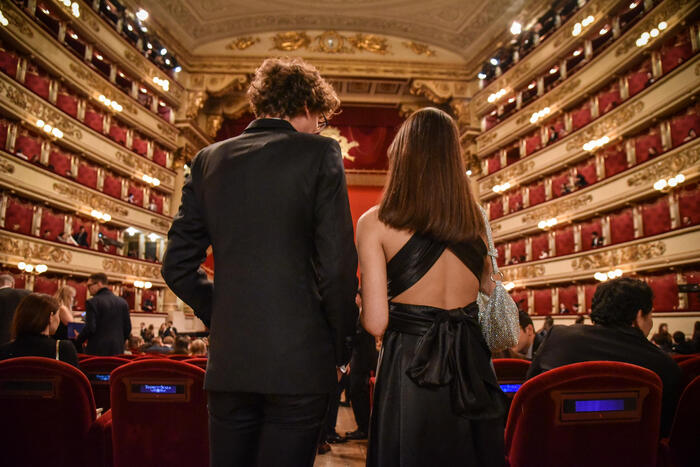This “Idomeneo” premiere has three winners: Constantinos Carydis, Hanna-Elisabeth Müller and Matthew Polenzani.
We have to talk about the rest.
Performances usually do not consist of the last 25 minutes. A rush, of course. But that would often help the cause immensely - as here: the king stands around undecided after his abdication, Mozart still has the peace aria “Torna la pace” up his sleeve. And in fact, after three and a half hours, the prelude to this, sorry Wolferl, show stopper begins. But the music quickly ebbs and flows away until the ex-ruler shrugs his shoulders and looks around in silence. That's it, its time is over.
A telling punchline, it's the best of this thin evening of directing.
And then the wild final chorus bursts, followed by the even wilder ballet music, which here, in this “Idomeneo” premiere of the Munich Opera Festival, is wonderfully played in full.
Dustin Klein came up with a wonderfully excited choreography for this.
In the state orchestra there is an explosion of colors, everything runs and races and rages, almost overtakes itself, throws itself drunk and delirious into the final chord.
Crazy good conducting by Constantinos Carydis
It's completely crazy, and the craziest of them all is at the desk. Constantinos Carydis is a repeat offender from Munich. At the State Opera he plugged Offenbach's “Tales of Hoffmann” with a nuclear power plant, most recently Mozart's “Le nozze di Figaro”. And you don't want to imagine how the “Idomeneo” in the Prinzregententheater would have dragged himself through the three acts without him.
Carydis has an idea for every single measure. Much is also contestable and very open to discussion - as is always the case with great art. But how he enforces his vision of this work seemingly unmoved and yet inspiring in the orchestra, how everything is analytically thought out and dramatically justified, how overwhelming goes hand in hand with questioning, that is terrific and ties in with the interpretations of René Jacobs. Carydis is far too serious and honest to be able to reveal anything about the effect (also in the great choir numbers).
And so this new production moves, it is the last in the era of artistic director Nikolaus Bachler, musically at the height of “Tristan” at the beginning of the opera festival.
As usual in previous years, there are again high show values, for which the visual arts are again responsible (after Georg Baselitz at “Parsifal”).
Associative, massive stage by Phyllida Barlow
The British Phyllida Barlow, the Haus der Kunst is dedicating a retrospective to her until Sunday, has come up with powerful associative elements. The recycling charm, the fused everyday materials that turn the ephemeral into something powerful and new, all of this fits the piece. There is a threatening rock that seems to be held in the air by poles with difficulty, as well as a catwalk with oily planks, which only signals supposed port security and stability. Once, Ilia and Idamante languish as if in two tree houses. A red rope can be net or gallows rope. And an ingenious lighting design makes it all shimmer ambiguously, once the rock in the penumbra becomes the open mouth of the sea monster.
Dumb, mute ghosts in colorful work clothes push everything around on the stage.
And it soon becomes clear, as undecided how it happens: with an equally telling director, it won't work tonight.
A third time, after Rossini's “Guillaume Tell” and Verdi's “Le vêpres siciliennes”, Antú Romero Nunes was entrusted with a splendidly sprawling to genre-bursting choir-soloist-ballet opus.
One can still get over the fact that he has no idea for the choir again.
The fact that his staging looks as if Mozart thought up nothing but two-dimensional to stereotyped figures (and also equipped them musically), goes by the master’s exciting early piece.
The director can hardly fill the scenery
Nunes seldom takes up Phyllida Barlow's offer, can hardly fill the scenery and restricts himself to the arrangement. Most of what moves is presumably self-made by the singers. And among them are two that would have been granted many more arias: Hanna-Elisabeth Müller is an ideal Elettra because she lets her lyrical socialization through, but can also unpack the large cutlery. It moves between the intimate and the hyper-aplomb and is always controlled. Likewise with Matthew Polenzani as Idomeneo. It may smear a bit in the coloratura. But in the lyric as in the heroic trumpeting he moves equally confidently.
Emily D'Angelo (Idamante), on the other hand, falls off a bit. The dark timbre and its intensity are distinctive, the restless vibrato and the lack of color are less. At first, Olga Kulchynska gropes her way through the high elevations of the Ilia, later she sings in a more soulful and free manner. Caspar Singh (high priest) is almost overstaffed, Martin Mitterrutzner is allowed to shoulder both Arbace arias with a courageous tenor commitment. In general, the version: It's a mixture of promenade. You can hear Mozart's fantasy in D that is alien to the work, including the famous concert aria “Ch'io mi scordi di te”, the original version of which was once heard in a private “Idomeneo” performance in Vienna. This opera, Carydis must also be reproached, does not actually need it, the music dramatist Mozart even less.
Further performances
on July 22nd, 24th and 26th (all sold out); Internet broadcast on July 24th, 6 p.m., on staatsoper.tv.









